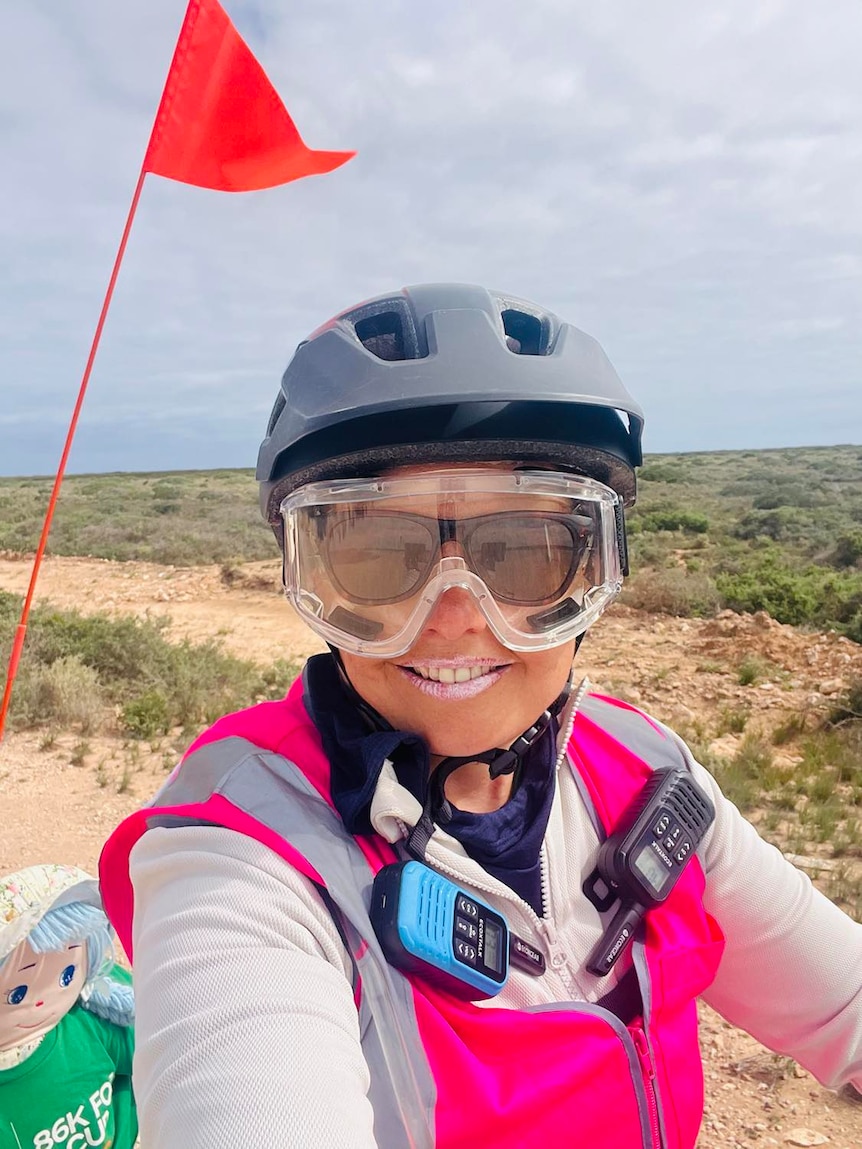Charissa Hanrahan gives one last push against the pedals and punches the air.
After weeks on the road, the 43-year-old has finally completed her mission of cycling 1,186 kilometres to raise money for child cancer research.
But the final route was far different to what she had imagined when she set out from Ceduna in South Australia to cycle across the Nullarbor.
Her message to anyone thinking of doing the same: “Rethink”.
‘Really quite scary’
Ms Hanrahan wanted to raise money for child cancer research after a close friend’s daughter, Lucy Galvin, who is now in remission, was diagnosed with cancer.
With her wife and two daughters following along in a support vehicle, she set off to cycle the Nullarbor from Ceduna on March 17, 2024.
But she was startled by the traffic’s intensity.
“It’s incredible but frightening at the same time,” Ms Hanrahan said.
“Every minute road trains were coming past.
“And the wind they throw off is really quite scary.”
Less than a week into the journey, Ms Hanrahan was cycling towards Eucla when devastating news came through her UHF radio.
A cyclist, 62-year-old Chris Barker, who was taking part in the epic Indian Pacific Wheel Ride, had been hit by a truck and killed only slightly further west along the Eyre Highway.
Less than two hours later, another cyclist taking part in the same event was also hit by a vehicle and seriously injured.
A tough call
Ms Hanrahan pulled into Eucla that day at the same time as other Indian Pacific Wheel Ride participants, which she said was “quite confronting and emotional”.
When she saw them putting their bikes on the back of a motorhome the next day, she questioned her plan.
“I thought to myself, if that’s what they’re doing, maybe I need to have a good, long, hard think about what I’m doing,” Ms Hanrahan said.
After having a conversation with a truck driver about just how vulnerable cyclists and people in slow-moving support vehicles were, she finally made the call to stop her Nullarbor crossing.
“It was very difficult,” Ms Hanrahan said.
“I did cry. There were a lot of emotions.”
Safety in the spotlight
The first person to cycle across the Nullarbor was Arthur Richardson, who spent 28 days picking his way across rough tracks and sand dunes in 1896.
But these days, the biggest threat to cyclists is the traffic.
Recent flood damage to the Trans-Australian Railway, forcing freight onto the road, has left the remote highway particularly busy.
Western Roads Federation chief executive Cam Dumesny said the trucking industry was horrified by Mr Barker’s death and met with peak cycling bodies this week to discuss ways to make the road safer.
From the trucking perspective, Mr Dumesny said they needed to be informed when large numbers of cyclists were expected.
He also said cyclists should know how difficult it was for a truck to suddenly swing around them.
“Cyclists are entitled to use the road, as are trucks,” Mr Dumesny said.
“We’ve just got to be more respectful of each other.
“Our road toll continues to rise. We’ve got to do something.”
A ‘heartwarming’ experience
Not all Nullarbor cycling experiences are negative.
Nicolai Bangsgaard is an extremely experienced long-distance adventurer, having cycled and scootered around 140,000 kilometres over the past 18 years across 87 different countries.
In March, the 47-year-old tackled the Nullarbor on a kick-scooter.
“Among long distance cyclists, it’s in the top 10 or 20 crossings to do in the world,” Mr Bangsgaard said.
He said the Eyre Highway was not busy when he went across in early March — possibly due to a flood closure — and he said he felt safe “almost 100 per cent of the time”.
“I was positively surprised by the road trains,” Mr Bangsgaard said.
“They gave me a wide berth all the time.”
His extensive experience also helped, saying he always moved well off the road when two road trains were passing at the same time, and “held his line” when one was coming past.
His advice to any other cyclists or scooter-riders thinking of tackling the road: Get a rear-view mirror.
“I would never travel without a rear-view mirror,” Mr Bangsgaard said.
“[That way] I’m in control.”
He described the journey as having “a lot of monotony, nothingness and outback bushland”.
Mr Bangsgaard said he recommended the journey, simply so others could experience the “heartwarming hospitality” of the people he met.
Finding a new path
Although Ms Hanrahan left the Nullarbor behind, she never abandoned her goal of cycling 1,186 kilometres.
She simply relocated, cycling lap after lap of the Esperance foreshore on a dedicated path to make up the remaining 612 kilometres.
“I’m just absolutely stoked to be finished,” Ms Hanrahan said, pulling up on April 2.
After leaving the Nullarbor, she initially “felt like she’d failed”.
But in hindsight, she is proud to have made what she believed was the right call for her safety and her family.
“It [opened my eyes] as to the way the family can operate as a team,” Ms Hanrahan said.
She still achieved her goal too, with the adventure bringing in more than $15,000 in fundraising for child cancer research.




